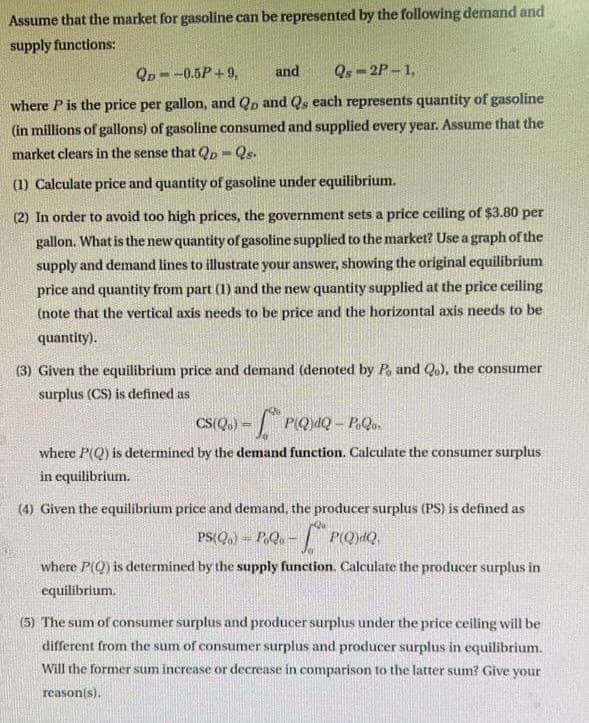Assume that the market for gasoline can be represented by the following demand and supply functions: QD--0.5P+9, and Qs-2P-1, where P is the price per gallon, and Qo and Qs each represents quantity of gasoline (in millions of gallons) of gasoline consumed and supplied every year. Assume that the market clears in the sense that QD=Qs. (1) Calculate price and quantity of gasoline under equilibrium. (2) In order to avoid too high prices, the government sets a price ceiling of $3.80 per gallon. What is the new quantity of gasoline supplied to the market? Use a graph of the supply and demand lines to illustrate your answer, showing the original equilibrium price and quantity from part (1) and the new quantity supplied at the price ceiling (note that the vertical axis needs to be price and the horizontal axis needs to be quantity). (3) Given the equilibrium price and demand (denoted by Po and Qo), the consumer surplus (CS) is defined as CS(Q.) - P(Q)dQ - P.Qo. where P(Q) is determined by the demand function. Calculate the consumer surplus in equilibrium. (4) Given the equilibrium price and demand, the producer surplus (PS) is defined as PS(Qa) = PaQa - P(Q)dQ, where P(Q) is determined by the supply function. Calculate the producer surplus in equilibrium. (5) The sum of consumer surplus and producer surplus under the price ceiling will be different from the sum of consumer surplus and producer surplus in equilibrium. Will the former sum increase or decrease in comparison to the latter sum? Give your
Assume that the market for gasoline can be represented by the following demand and supply functions: QD--0.5P+9, and Qs-2P-1, where P is the price per gallon, and Qo and Qs each represents quantity of gasoline (in millions of gallons) of gasoline consumed and supplied every year. Assume that the market clears in the sense that QD=Qs. (1) Calculate price and quantity of gasoline under equilibrium. (2) In order to avoid too high prices, the government sets a price ceiling of $3.80 per gallon. What is the new quantity of gasoline supplied to the market? Use a graph of the supply and demand lines to illustrate your answer, showing the original equilibrium price and quantity from part (1) and the new quantity supplied at the price ceiling (note that the vertical axis needs to be price and the horizontal axis needs to be quantity). (3) Given the equilibrium price and demand (denoted by Po and Qo), the consumer surplus (CS) is defined as CS(Q.) - P(Q)dQ - P.Qo. where P(Q) is determined by the demand function. Calculate the consumer surplus in equilibrium. (4) Given the equilibrium price and demand, the producer surplus (PS) is defined as PS(Qa) = PaQa - P(Q)dQ, where P(Q) is determined by the supply function. Calculate the producer surplus in equilibrium. (5) The sum of consumer surplus and producer surplus under the price ceiling will be different from the sum of consumer surplus and producer surplus in equilibrium. Will the former sum increase or decrease in comparison to the latter sum? Give your
Managerial Economics: Applications, Strategies and Tactics (MindTap Course List)
14th Edition
ISBN:9781305506381
Author:James R. McGuigan, R. Charles Moyer, Frederick H.deB. Harris
Publisher:James R. McGuigan, R. Charles Moyer, Frederick H.deB. Harris
Chapter4: Estimating Demand
Section: Chapter Questions
Problem 6E
Related questions
Question

Transcribed Image Text:Assume that the market for gasoline can be represented by the following demand and
supply functions:
QD--0.5P+9,
and
Qs-2P-1,
where P is the price per gallon, and QD and Qs each represents quantity of gasoline
(in millions of gallons) of gasoline consumed and supplied every year. Assume that the
market clears in the sense that QD-Qs.
(1) Calculate price and quantity of gasoline under equilibrium.
(2) In order to avoid too high prices, the government sets a price ceiling of $3.80 per
gallon. What is the new quantity of gasoline supplied to the market? Use a graph of the
supply and demand lines to illustrate your answer, showing the original equilibrium
price and quantity from part (1) and the new quantity supplied at the price ceiling
(note that the vertical axis needs to be price and the horizontal axis needs to be
quantity).
(3) Given the equilibrium price and demand (denoted by Po and Qo), the consumer
surplus (CS) is defined as
CS(Q.) - P(Q)dQ - P.Qo.
where P(Q) is determined by the demand function. Calculate the consumer surplus
in equilibrium.
(4) Given the equilibrium price and demand, the producer surplus (PS) is defined as
PS(Qa) = PaQa - P(Q)dQ,
where P(Q) is determined by the supply function. Calculate the producer surplus in
equilibrium.
(5) The sum of consumer surplus and producer surplus under the price ceiling will be
different from the sum of consumer surplus and producer surplus in equilibrium.
Will the former sum increase or decrease in comparison to the latter sum? Give your
reason(s).
Expert Solution
This question has been solved!
Explore an expertly crafted, step-by-step solution for a thorough understanding of key concepts.
This is a popular solution!
Trending now
This is a popular solution!
Step by step
Solved in 4 steps with 1 images

Recommended textbooks for you

Managerial Economics: Applications, Strategies an…
Economics
ISBN:
9781305506381
Author:
James R. McGuigan, R. Charles Moyer, Frederick H.deB. Harris
Publisher:
Cengage Learning

Managerial Economics: Applications, Strategies an…
Economics
ISBN:
9781305506381
Author:
James R. McGuigan, R. Charles Moyer, Frederick H.deB. Harris
Publisher:
Cengage Learning